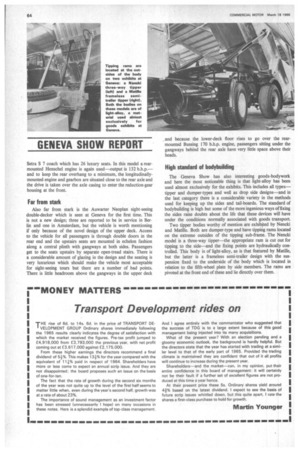GENEVA SHOW REPORT
Page 66

If you've noticed an error in this article please click here to report it so we can fix it.
Setra S 7 coach which has 26 luxury seats. In this model a rearmounted Henschel engine is again used—output is 132 b.h.p.— and to keep the rear overhang to a minimum, the longitudinallymounted engine and gearbox are situated close to the rear axle and the drive is taken over the axle casing to enter the reduction-gear housing at the front.
Far from stark Also far from stark is the Auwarter Neaplan sight-seeing double-decker which is seen at Geneva for the first time. This is not a new design; three are reported to be in service in Berlin and one in Amsterdam, but the vehicle is worth mentioning if only because of the novel design of the upper deck. Access to the vehicle for all passengers is through double doors in the rear end and the upstairs seats are mounted in echelon fashion along a central plinth with gangways at both sides. Passengers get to the seats upstairs by separate open-tread stairs. There is a considerable amount of glazing in the design and the seating is very luxurious which should make the vehicle most acceptable for sight-seeing tours but there are a number of bad points. There is little headroom above the gangways in the upper deck and because the lower-deck floor rises to go over the rearmounted Bussing 170 b.h.p. engine, passengers sitting under the gangways behind the rear axle have very little space above their heads.
High standard of bodybuilding The Geneva Show has also interesting goods-bodywork and here the Most noticeable thing is that light-alloy has been used almost exclusively for the exhibits. This includes all types— tipper and dumper-types and well as drop side designs—and in the last category there is a considerable variety in the methods used for keeping up the sides and tail-boards. The standard of bodybuilding is high but some of the more ingenious ways of fixing the sides raise doubts about the life that these devices will have under the conditions normally associated with goods transport.
Two tipper bodies worthy of mention are exhibited by Nencld and Matille. Both are dumper-type and have tipping rams located on the extreme outsides of the tipping sub-frame. The Nencki model is a three-way tipper—the appropriate rain is cut out for tipping to the side—and the fixing points are hydraulically controlled. This body is of light-alloy, as is that featured by Matille, but the latter is a frameless semi-trailer design with the suspension fixed to the underside of the body which is located in relation to the fifth-wheel plate by side members. The rams are pivoted at the front end of these and lie directly over them.




































































































































































